HUNTINGTON, N.S. — There’s been lots of speculation on how snapping turtles made it to Cape Breton, but a recent study concludes they simply walked here.
Slowly.
“It’s long been known the snapping turtle is native to Nova Scotia, but our recent research also suggests it’s native to Cape Breton Island,” said Terry Power, regional biologist for the provincial Department of Lands and Forestry.
“The Mira River watershed area seems to be the centre of distribution.”
Power, along with former Nova Scotia Museum curator emeritus John Gilhen, spent several years researching snapping turtles in Cape Breton and recently published a report in the Canadian Field Naturalist, a peer-reviewed scientific journal publishing ecology, behaviour, taxonomy, conservation, and other topics relevant to Canadian natural history.
The first sighting of the snapping turtle in Cape Breton was documented in 1953 by Dr. Sherman Bleakney, a researcher from Acadia University.
Power said during their research they looked through all the data from 1953 until the present.
“We looked at the current distribution in Eastern Canada and elsewhere together with other native freshwater turtles as well and looked at several studies,” he said.
“The few scattered reports of snapping turtles that were published were (found) near roads and considered to be potentially released individual (turtles), brought in from the mainland.”
Facts to snap up:
- The snapping turtle is Nova Scotia’s largest freshwater turtle and its shell length can be more than 50cm.
- The snapping turtle can live well past 50 years of age.
- The snapping turtle is protected in Nova Scotia under both the Wildlife Act and the Endangered Species Act. These reptiles are listed on the Canadian Species at Risk Act as a “special concern” and are listed as vulnerable Under the Nova Scotia Endangered Species Act.
- The sex of a turtle — whether they turn into male or female — is determined by nest temperatures.
- One of the biggest threats to snapping turtles is adult mortality and among the main cause is being struck by a motor vehicle.
- Wood turtles have always been present in Cape Breton —predominantly in the River Denys and River Inhabitants areas — published in John Gilhen’s book “Amphibians and Reptiles of Nova Scotia” in 1984.
- The public is reminded not to disturb turtles or their nests and to report any concerns or sightings of snapping turtles to Nova Scotia Lands and Forestry in Sydney at 902-563-3370.
Research included looking at the existence of a land bridge between Cape Breton and mainland Nova Scotia, thousands of years ago.
Power said there is no absolute proof when snapping turtles first came to Cape Breton but the most likely scenario surrounding their arrival here is believed to have taken place during what was considered the post-glacial period.
Looking at the dispersal of species during that period, Power said sea levels were lower as the glaciers were retreating, and land levels were higher. The land bridge is believed to have had its greatest extension approximately 9,000 to 10,000 years ago.
“Which is the mechanism (by which) land animals would have recolonized in the islands of the Gulf of St. Lawrence during the post glacier period,” he said.
However, Power feels snapping turtles may not caught the public eye over the years because no one has ever really spent much time looking for them.
A snapping turtle is almost entirely aquatic and is rarely seen. They mainly venture on land during nesting season in June and July.
Based on reports from the public as well as from the Nova Scotia Museum, there were 72 snapping turtle sightings in Cape Breton between 1953 and 2017.
“Most were in the watershed area, but reports were scattered over Cape Breton County and Richmond County,” he said.
“The majority of those were reported during the June-July nesting season, suspected to be nesting females.”
Related:
• Snapping turtle sightings growing in Cape Breton
Power said females have various nesting areas but like to lay their eggs in gravel along soft road shoulders.
“Females can be seen searching for nesting areas along roadsides in open gravel areas created by humans.”
Where the turtles live in the same environment and are subjected to the same temperature conditions and lay eggs at the same time, it wouldn’t be unusual to see a number of turtles searching for nesting areas at the same time, he said.
Power said one can drive the same road every day and never see a turtle and all of a sudden see six.
“The onset of nesting of snapping turtles is synchronous.”
Power said there’s no way of knowing for sure how healthy the population is.
A turtle lays an average of 45 eggs at a time — but can lay upwards of 70 — and nests for 30-40 years, really just trying to replace herself.
“That’s an incredible effort. All a female turtle needs to replace herself is for one turtle to reach adulthood.”
However, Power said what’s not known is if there is any recruitment into that population or not.
The turtle eggs are often dug up by other animals and even when they do hatch they have to get from their nest to wherever they are going to live and could get run over by a car or picked up by a crow.
“There’s all different kinds of mortality along the way.”
Power said if someday down the road there are no turtles, then there was no recruitment into that population to replace the ones that were already there because of whatever mortality was affecting turtles from the egg stage to when they become adults.
Kelly Huntington, 48, of Huntington, said she’s always seen snapping turtles in the area.
“I’ve always seen them but not as many as I’ve seen in the last few years.”
Nine years ago, Huntington came across a disturbed turtle nest.
“Something dug up a nest at my house, right at the end of my driveway, either a raccoon or one of the dogs. We rescued two eggs, put a cloth over them and put them in a box and one hatched overnight.”
Where Murtle was raised in captivity, Huntington said an enclosure was built for her at the Two Rivers Wildlife Park that even includes a natural pool.
Huntington said they’ve seen other snapping turtles in the park area as well.
“We don’t touch any of the turtles in the wild, the only reason we took Murtle was because she hatched at the house.”








